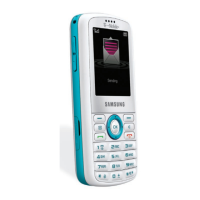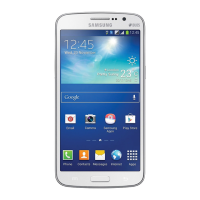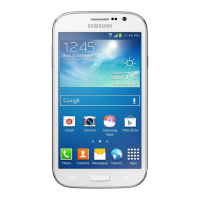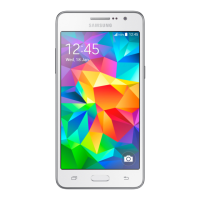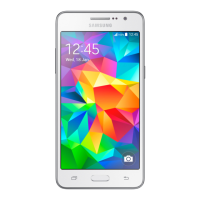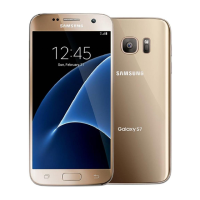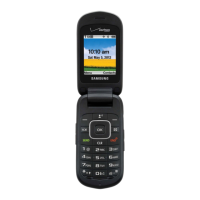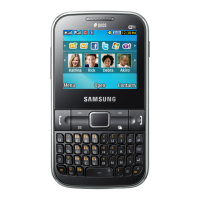Do you have a question about the Samsung GreatCall and is the answer not in the manual?
Explains the structure and symbols used within the guide for clarity and easy reference.
Lists and describes the essential components included in the Jitterbug phone package for initial setup.
Details the purpose and function of the Jitterbug's rechargeable battery for powering the device.
Provides step-by-step instructions for inserting and taking out the battery from the Jitterbug phone.
Guides users on how to charge the Jitterbug battery using the provided charger and wall outlet.
Explains how the phone displays battery status and provides low battery alerts to the user.
Identifies and describes the key components and features located on the front of the Jitterbug phone.
Identifies and describes the key components and features located on the back of the Jitterbug phone.
Identifies and describes the key components and features located on the inside of the Jitterbug phone.
Explains the different areas of the phone's internal screen and their functions for user interaction.
Covers initial setup steps, including powering on and understanding the main screen for new users.
Guides users on how to initiate their first phone call using the Jitterbug, either manually or via contacts.
Provides clear instructions on how to properly power down the Jitterbug phone when not in use.
Highlights features and services available for customizing the Jitterbug experience to user preferences.
Explains how to use the voice command feature to make calls or access phone functions hands-free.
Details how to contact live operators for assistance with phone book management or service inquiries.
Provides contact information for customer support via email, phone, or postal mail for assistance.
Provides critical instructions on how to place an emergency call using the Jitterbug phone.
Covers various methods for initiating phone calls, including manual dialing and using the phone book.
Explains how to activate and use the speakerphone function for hands-free conversations.
Describes how the phone indicates incoming calls and the steps to answer them.
Provides instructions on how to properly terminate an active phone call.
Explains how to decline an incoming call and route it directly to voicemail.
Details how to set the phone to vibrate for incoming call alerts instead of audible ringing.
Guides users on how to control the loudness of incoming call alerts and notifications.
Explains how to adjust the audio volume during an active call for optimal clarity.
Describes how to manage multiple incoming calls while already engaged in a conversation.
Covers managing contact entries, including adding new contacts, editing, and removing them.
Instructions for registering an account on MyGreatCall.com for phone management and updates.
Step-by-step guide for adding contacts directly via the phone's interface and keypad.
Explains how to view a log of the most recent outgoing, incoming, and missed phone calls.
Guides users on how to redial numbers directly from the call history log.
Overview of how to access and navigate the phone's settings menu for customization.
Instructions on how to change the color theme of the phone's internal screen from available options.
Details how to select different audible sounds for incoming call alerts and notifications.
Instructions for enabling or disabling the startup sound played when the phone powers on.
Information on enabling and managing Bluetooth connectivity for compatible accessories.
Explains how to use voice commands to initiate calls by speaking contact names.
Step-by-step guide for configuring the voicemail service for the first time.
Instructions on how to record or change the outgoing message for voicemail.
Details how the phone notifies users about new voicemail messages via display and sound.
Guides users on how to access and listen to new voicemail messages on their Jitterbug.
Explains how to retrieve and listen to previously saved voicemail messages.
Overview of the text messaging service and its capabilities for sending and receiving messages.
How the phone alerts users to incoming text messages via light, display, and audible alerts.
Instructions for accessing and viewing received text messages on the Jitterbug.
Guides users on how to respond to received text messages, including using presets or custom text.
Explains how to manage text messages by saving them for later or deleting unwanted ones.
Provides methods for removing unwanted text messages, either immediately after reading or from saved messages.
Step-by-step instructions for composing and sending text messages to contacts or numbers.
General information about Bluetooth technology and its use with the Jitterbug for wireless connectivity.
Guides on connecting and using a specific Bluetooth headset model with the Jitterbug phone.
Instructions for enabling or disabling the Bluetooth function on the Jitterbug phone.
Steps to put the Bluetooth headset into pairing mode for initial connection.
Instructions for putting the Jitterbug phone into pairing mode to connect with Bluetooth devices.
How to answer incoming calls using a connected Bluetooth headset.
How to terminate an active call using a connected Bluetooth headset.
Information regarding the impact of Bluetooth usage on the phone's battery performance.
Details FCC regulations and SAR information regarding RF energy exposure from wireless devices.
Information on responsible recycling of Samsung mobile products and accessories.
Safety instructions and compliance information for the phone's included travel adapter.
FDA-related information and questions concerning wireless phone usage and potential health effects.
Explains the FDA's responsibilities and actions regarding wireless phone safety and regulations.
Practical advice on minimizing exposure to RF energy from wireless devices.
Discusses safety considerations and recommendations for children using wireless phones.
Examines whether hands-free kits affect RF exposure risks from wireless phones.
Addresses potential interference between wireless phones and medical devices like pacemakers.
Guidelines and tips for using wireless phones safely and responsibly while driving.
Advice on protecting hearing from loud audio exposure, including safe phone use practices.
Safety precautions related to using the phone in specific environmental conditions and locations.
Information on FCC regulations ensuring wireless phone compatibility with hearing aids.
Guidance on using the Jitterbug with other personal medical devices and potential RF interference.
Safety warnings for using the phone in areas with potentially explosive atmospheres.
Detailed instructions on how to place emergency calls from the Jitterbug in various situations.
Important notices and cautions regarding FCC compliance, phone usage, and modifications.
General safety guidelines for phone operation, installation, handling, and aircraft usage.
Information on factors affecting phone performance, such as signal reception and power save features.
Explanation of the basic radio transmission principles and power control of the Jitterbug phone.
Factors influencing the phone's battery life and usage times, including network and feature settings.
Essential safety guidelines and warnings related to the phone's battery handling, charging, and disposal.
Recommendations for maintaining the Jitterbug phone's condition and longevity through proper care.
Defines and outlines the intellectual property rights related to the Jitterbug phone and its associated software.
States limitations and exclusions of warranties provided by the manufacturer for the product.
Details the terms, coverage, and duration of the limited warranty for the phone and accessories.
Outlines the responsibilities of the manufacturer regarding product repair or replacement under warranty.
Specifies the limitations on the manufacturer's warranty and liability for product defects or issues.
Explains the structure and symbols used within the guide for clarity and easy reference.
Lists and describes the essential components included in the Jitterbug phone package for initial setup.
Details the purpose and function of the Jitterbug's rechargeable battery for powering the device.
Provides step-by-step instructions for inserting and taking out the battery from the Jitterbug phone.
Guides users on how to charge the Jitterbug battery using the provided charger and wall outlet.
Explains how the phone displays battery status and provides low battery alerts to the user.
Identifies and describes the key components and features located on the front of the Jitterbug phone.
Identifies and describes the key components and features located on the back of the Jitterbug phone.
Identifies and describes the key components and features located on the inside of the Jitterbug phone.
Explains the different areas of the phone's internal screen and their functions for user interaction.
Covers initial setup steps, including powering on and understanding the main screen for new users.
Guides users on how to initiate their first phone call using the Jitterbug, either manually or via contacts.
Provides clear instructions on how to properly power down the Jitterbug phone when not in use.
Highlights features and services available for customizing the Jitterbug experience to user preferences.
Explains how to use the voice command feature to make calls or access phone functions hands-free.
Details how to contact live operators for assistance with phone book management or service inquiries.
Provides contact information for customer support via email, phone, or postal mail for assistance.
Provides critical instructions on how to place an emergency call using the Jitterbug phone.
Covers various methods for initiating phone calls, including manual dialing and using the phone book.
Explains how to activate and use the speakerphone function for hands-free conversations.
Describes how the phone indicates incoming calls and the steps to answer them.
Provides instructions on how to properly terminate an active phone call.
Explains how to decline an incoming call and route it directly to voicemail.
Details how to set the phone to vibrate for incoming call alerts instead of audible ringing.
Guides users on how to control the loudness of incoming call alerts and notifications.
Explains how to adjust the audio volume during an active call for optimal clarity.
Describes how to manage multiple incoming calls while already engaged in a conversation.
Covers managing contact entries, including adding new contacts, editing, and removing them.
Instructions for registering an account on MyGreatCall.com for phone management and updates.
Step-by-step guide for adding contacts directly via the phone's interface and keypad.
Explains how to view a log of the most recent outgoing, incoming, and missed phone calls.
Guides users on how to redial numbers directly from the call history log.
Overview of how to access and navigate the phone's settings menu for customization.
Instructions on how to change the color theme of the phone's internal screen from available options.
Details how to select different audible sounds for incoming call alerts and notifications.
Instructions for enabling or disabling the startup sound played when the phone powers on.
Information on enabling and managing Bluetooth connectivity for compatible accessories.
Explains how to use voice commands to initiate calls by speaking contact names.
Step-by-step guide for configuring the voicemail service for the first time.
Instructions on how to record or change the outgoing message for voicemail.
Details how the phone notifies users about new voicemail messages via display and sound.
Guides users on how to access and listen to new voicemail messages on their Jitterbug.
Explains how to retrieve and listen to previously saved voicemail messages.
Overview of the text messaging service and its capabilities for sending and receiving messages.
How the phone alerts users to incoming text messages via light, display, and audible alerts.
Instructions for accessing and viewing received text messages on the Jitterbug.
Guides users on how to respond to received text messages, including using presets or custom text.
Explains how to manage text messages by saving them for later or deleting unwanted ones.
Provides methods for removing unwanted text messages, either immediately after reading or from saved messages.
Step-by-step instructions for composing and sending text messages to contacts or numbers.
General information about Bluetooth technology and its use with the Jitterbug for wireless connectivity.
Guides on connecting and using a specific Bluetooth headset model with the Jitterbug phone.
Instructions for enabling or disabling the Bluetooth function on the Jitterbug phone.
Steps to put the Bluetooth headset into pairing mode for initial connection.
Instructions for putting the Jitterbug phone into pairing mode to connect with Bluetooth devices.
How to answer incoming calls using a connected Bluetooth headset.
How to terminate an active call using a connected Bluetooth headset.
Information regarding the impact of Bluetooth usage on the phone's battery performance.
Details FCC regulations and SAR information regarding RF energy exposure from wireless devices.
Information on responsible recycling of Samsung mobile products and accessories.
Safety instructions and compliance information for the phone's included travel adapter.
FDA-related information and questions concerning wireless phone usage and potential health effects.
Explains the FDA's responsibilities and actions regarding wireless phone safety and regulations.
Practical advice on minimizing exposure to RF energy from wireless devices.
Discusses safety considerations and recommendations for children using wireless phones.
Examines whether hands-free kits affect RF exposure risks from wireless phones.
Addresses potential interference between wireless phones and medical devices like pacemakers.
Guidelines and tips for using wireless phones safely and responsibly while driving.
Advice on protecting hearing from loud audio exposure, including safe phone use practices.
Safety precautions related to using the phone in specific environmental conditions and locations.
Information on FCC regulations ensuring wireless phone compatibility with hearing aids.
Guidance on using the Jitterbug with other personal medical devices and potential RF interference.
Safety warnings for using the phone in areas with potentially explosive atmospheres.
Detailed instructions on how to place emergency calls from the Jitterbug in various situations.
Important notices and cautions regarding FCC compliance, phone usage, and modifications.
General safety guidelines for phone operation, installation, handling, and aircraft usage.
Information on factors affecting phone performance, such as signal reception and power save features.
Explanation of the basic radio transmission principles and power control of the Jitterbug phone.
Factors influencing the phone's battery life and usage times, including network and feature settings.
Essential safety guidelines and warnings related to the phone's battery handling, charging, and disposal.
Recommendations for maintaining the Jitterbug phone's condition and longevity through proper care.
Defines and outlines the intellectual property rights related to the Jitterbug phone and its associated software.
States limitations and exclusions of warranties provided by the manufacturer for the product.
Details the terms, coverage, and duration of the limited warranty for the phone and accessories.
Outlines the responsibilities of the manufacturer regarding product repair or replacement under warranty.
Specifies the limitations on the manufacturer's warranty and liability for product defects or issues.
| Brand | Samsung |
|---|---|
| Model | GreatCall |
| Category | Cell Phone |
| Language | English |
